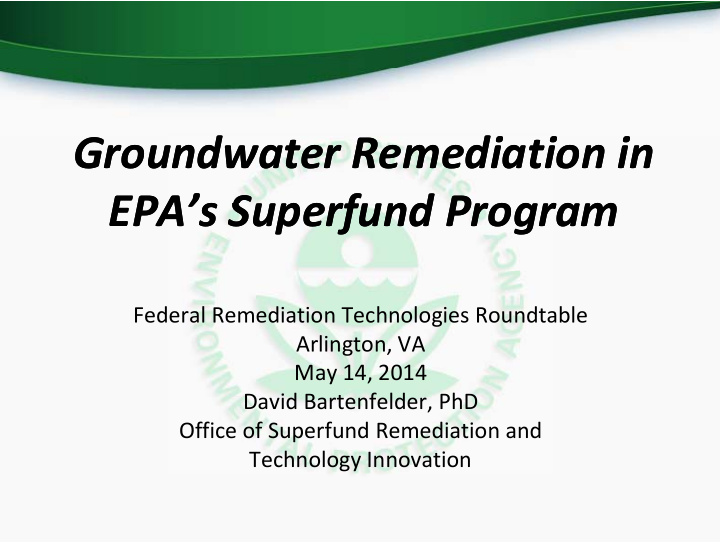



Groundwater Remediation in Groundwater Remediation in d d di di i i i i EPA’s Superfund Program EPA’s Superfund Program EPA’s Superfund Program EPA’s Superfund Program Federal Remediation Technologies Roundtable A li Arlington, VA t VA May 14, 2014 David Bartenfelder, PhD David Bartenfelder, PhD Office of Superfund Remediation and Technology Innovation
Presentation Topics Presentation Topics • Importance of Groundwater • Importance of Groundwater • Cleanup Expectations p p • Technical Impracticability (TI) Waiver • New Suite of Groundwater Guidance 2
Importance of Groundwater Importance of Groundwater • Protection of water, including groundwater, is one of Protection of water, including groundwater, is one of EPA Administrator McCarthy’s 7 priorities • 90% of current Superfund NPL sites include a groundwater remedy g y • EPA spends ~$30-50 million/year on the operation of long-term response actions for the first 10 years of restoration actions 3
Superfund Groundwater Cleanup Expectations Superfund Groundwater Cleanup Expectations • Define and contain the plume – stop the migration p p g • Early actions as soon as possible - address the source(s) • Restore to beneficial use wherever practicable • Institutional controls should not be the only response • Institutional controls should not be the only response • If restoration not technically practicable – Technical Impracticability (TI) Waiver 4
Remedial Endpoints Remedial Endpoints • Restoration • Restoration • Non-restoration – (TI) 5
Progress in Groundwater Cleanups Progress in Groundwater Cleanups • Over the 3 decades of Superfund cleanups, progress has been p p , p g made in cleaning up and restoring contaminated groundwater • Many Superfund groundwater remedies have met remedial a y Supe u d g ou d a e e ed es a e e e ed a action objectives • Where remedies have not achieved objectives, significant Where remedies have not achieved objectives, significant progress has been made to reduce contaminant concentrations • Technologies and strategies have evolved over time • Technologies and strategies have evolved over time (Source: EPA, 2013. Superfund Remedy Report, 14 th Ed. http://www epa gov/superfund/remedytech/srr/) http://www.epa.gov/superfund/remedytech/srr/) 6
Selection Trends for Groundwater Pump and Treat and In Situ Remedies (FY 1986 – 2011) and In Situ Remedies (FY 1986 2011) From: EPA Superfund Remedy Report, 14 th Edition (Nov. 2013)
Challenges at Groundwater Cleanups g p • Making progress on many groundwater remedies but can take decades to complete • Technical challenges – Fractured bedrock – Matrix diffusion – DNAPL DNAPL • Costly to build and operate remediation systems 8
Alternative Remedial Strategy gy • TI just one of six ARAR waivers • Most TI waivers for GW, but a few for SW • 100+ TI waivers granted to date • Waivers based on: • Waivers based on: – Contaminant chemical and physical properties – Remedial technology Remedial technology – Subsurface geology – Time – Subordinate cost 9
I Issues at Groundwater Cleanups t G d t Cl • Remedy objectives may not be clearly defined • Evaluation of progress difficult without interim Evaluation of progress difficult without interim milestones • Remedies may have reached technical limitations R di h h d t h i l li it ti • Lack of consensus among site team and/or stakeholders, at some sites 10
How to address these challenges? How to address these challenges? New suite of guidance providing a path to complete sites: • Focusing resources on making site decisions • Identifying criteria for determining progress and attainment of remedial action objectives and cleanup j p levels • Providing a scientific and defensible basis to make idi i ifi d d f ibl b i k cleanup decisions 11
New Suite of Groundwater Guidance New Suite of Groundwater Guidance • Groundwater Road Map (2011) p ( ) • Guidance for Evaluating Completion of Groundwater Restoration Remedial Actions (Nov. 2013) R t ti R di l A ti (N 2013) – Recommended Approach for Evaluating Completion of Groundwater Restoration Remedial Actions (May/June 2014) – Groundwater Statistics Tool (May/June 2014) Groundwater Statistics Tool (May/June 2014) • Groundwater Remedy Completion Strategy (May 2014) 12
Groundwater Remedy Completion Strategy ( (May 2014, OSWER 9200.2-144) 20 OS 9200 2 ) • Helps to focus limited resources toward efficient and effective Helps to focus limited resources toward efficient and effective completion of groundwater remedies • Recommends including site decision points along the process and g p g p encourages site-specific decision making • Encourages re-evaluation of remedial strategy if not making reasonable g gy g progress • Promotes stakeholder consensus 13
Groundwater Strategy (cont.) Groundwater Strategy (cont.) • Does not – alter the Agency approach for setting remedial objectives or cleanup levels – change existing regulations, guidance or policy including remedy selection – address groundwater classifications or groundwater use designations – request state/tribes alter existing groundwater t t t /t ib lt i ti d t classification or use designation 14
Summary • Superfund Program striving to maximize p g g environmental protection • Better define site completion – Process Process – Metrics • Better utilize TI waivers where appropriate 15
Contacts Contacts • Anne Dailey (703-347-0373; dailey.anne@epa.gov) • Kate Garufi (703-603-8827; garufi.katherine@epa.gov) • Dave Bartenfelder (703-603-9047; bartenfelder.david@epa.gov) 16
Recommend
More recommend